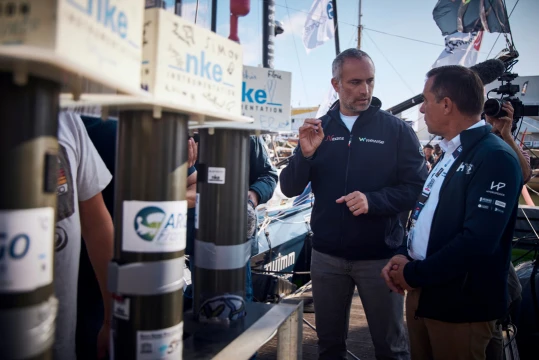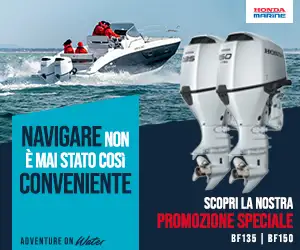
The Vendée Globe skippers will take scientific measuring equipment with them
More than half of the skippers who are about to take on the tenth Vendée Globe has a scientific collaboration project. They will sail with scientific measuring apparatus which will allow them to take measurements on the ocean. On Tuesday this week the skippers involved all received this equipment in the presence of the president of the Vendée Globe and the Departmental Council of Vendée, Alain Leboeuf and Emanuela Rusciano, representative of UNESCO.
What is the objective of this program?
It is part of the Decade for the Oceans (2021-2030) an ambitious partnership shared between UNESCO, the Vendée Globe and the IMOCA Class. It is a program which aims to advance oceanographic research and weather forecasting models. Twenty-five sailors will carry marine weather- measuring instruments during the race. Their contribution will allow essential data to be collected and distributed to scientists in real time. This will help enrich global knowledge on climate and the ocean and improving operational weather forecasting services, particularly in the less frequented areas of the globe such as the ocean of the Big South.
This scientific equipment is provided by a number of institutes, all of them stakeholders in the Global Ocean Observing System (GOOS): Ifremer, Météo France, UK MetOffice, CNES, GEOMAR, CLS, TARA Foundation, ETH Zurich. The technical coordination of all these instruments and operations will be overseen by the UNESCO International Centre of Excellence for the Coordination and Monitoring of Meteorological and Oceanographic Observing Systems (OceanOPS). These initiatives are correlated with educational programs conducted in partnership within schools or colleges.
What instruments will the skippers be carrying?
There are six types of instruments deployed that were given to the skippers this Tuesday.
- Ten skippers will be carrying an Argo float. 1.70 m long and weighing 20 kg, it measures temperature and salinity, which allows for weather and oceanography modelling.
- The drifting buoy or weather buoy measures atmospheric pressure, temperature and surface current. Weighing 20 kg and carried by eight skippers, it provides useful information for global and regional forecasts. The data collected by the beacon is also useful for climate research, ocean monitoring and forecasting.
- Complementing these aforementioned devices, the weather station is a box fixed inside the boat that measures the atmospheric forecast. Much smaller and lighter (it weighs 300 grams), it is fixed inside the boat and is connected to the on-board computer. - The TSG Gaillard, a 10 kg device, also allows continuous readings to be taken. Carried on two boats, it is a simple-to-use tool that measures temperature and salinity. Ifremer, who developed it, would like to extend its use to the world of recreational sailing.
- The Calitoo photometer is a small portable device weighing 400 grams that will be on five boats. It takes measurements of the level of aerosols present in the atmosphere and sorts them according to their size (smoke, pollutant gas, ice crystals, dust). This makes it possible to measure the optical depth, a measure of the amount of light that is absorbed when passing through an environment.
- Finally, two Argos Marget II beacons, weighing 1.3 kg, will be taken. They make it possible to measure marine currents. The aim is to highlight a major marine current and to help raise awareness of our understanding of the ocean.
And what do the skippers think?
Throughout the afternoon, skippers and their teams received their scientific tools. "We are lucky to be able to travel around the world and go on routes that are rarely used," explains Louis Burton (Bureau Vallée) who will be taking a Calitoo photometer. “If it can be useful to those who pay attention to what is happening in the atmosphere and help to keep nature beautiful, I think that's great."
Antoine Cornic (Human Immobilier) is taking several pieces of scientific equipment including a weather buoy. "Since I've been in IMOCA, I've always volunteered for stuff like this, I really do it with pleasure," he explains. “I like science, I like the idea that we can help advance knowledge and that it can help raise awareness among younger generations."
Fabrice Amedeo (Nexans -Wewise) has transformed his IMOCA into an "educational boat." "My project is focused on preserving the oceans," he explains. On board, he has three sensors (CO2 and salinity, microplastics, biodiversity) and buoys to help analyze the size of waves and currents. In addition, he received an Argo float this afternoon. "I know that all the data collected is very valuable in terms of climate, oceanography and even meteorology."
Among the other sailors to have taken an Argo float are two race rookies: Guirec Soudée (Freelance.com) and Sam Goodchild (VULNERABLE). They will have to drop them in the 40s, between Brazil and South Africa. "I would have felt bad not to take this on board my boat," explains Soudée. "It's not very heavy (20 kg) and it allows us to collect data that will benefit a lot of people, including us sailors." Each beacon is also attached to a class, "it adds meaning to this approach" says Soudée. "If scientists tell us that it is useful and that it helps them in their research, we need tohelp them,” agrees Sam Goodchild. “We go to areas where they have little data so it seems logical".
Oliver Heer (Tut Gut.), Boris Herrmann (Malizia - Seaexplorer) and Nicolas Lunven (Holcim-PRB) embark a sort of large case, the OceanPack. "It allows us to collect small samples of seawater all along the course,” explains Lunven. “This allows us to analyze several parameters such as salinity, temperature, oxygen and CO2. All of this data contributes to improving our knowledge of the health of the oceans. It is also thanks to this type of initiative that we are able to understand climate change and its implications for water a little better".
Why is the Vendée Globe acting?
Alain Leboeuf, president of the Vendée Globe and the Vendée Departmental Council, was present to participate in this presentation of scientific equipment alongside the skippers and Emanuela Rusciano, UNESCO's science and communications manager.
"As part of this 10th edition, I was keen to to give a new environmental vision to the Vendée Globe, he explains. This race and these skippers must serve humanity by helping our scientists to capture data and work on the future of the planet." Said Alain Leboeuf who wishes to salute the skippers, "More than half of them have taken a gamble on the future and the environment. We are working for today and even more so for tomorrow," he assures.
The president of the Vendée Globe and the Vendée Departmental Council also pointed out that during the next edition, in 2028, it will be mandatory to transport scientific equipment. Finally, Alain Leboeuf announced that there will be two biodiversity protection zones (exclusion zones) around the Azores and Cape Verde on the course of this 10th edition.
What equipment does each skipper take?
Oliver Heer (OceanPack + Argo Float)
Antoine Cornic (TSG Gaillard + Weather Buoy + Weather Station)
Tanguy Le Turquais (Weather Station)
Kojiro Shiraishi (Argo Float)
Sam Goodchild (Argo Float + Calitoo)
Sébastien Marsset (Weather Station + Argo Float)
Romain Attanasio (TSG Gaillard + Weather Buoy)
Boris Herrmann (OceanPack + Weather Buoy)
Guirec Soudée (Argo Float)
Maxime Sorel (Argo Float)
Szabi WEORES (Argo Float + Weather Station)
Arnaud Boissières (Weather Buoy + Calitoo)
Sam Davies (Calitoo)
Pip Hare (Calitoo)
Paul Meilhat (Planctoscope)
Nicolas Lunven (OceanPack)
Benjamin Dutreux (Weather Station)
Clarisse Crémer (Weather Buoy)
Denis Van Weynbergh (Bouée Météo)
Fabrice Amedeo (OceanPack + Flotteur Argo)
Yoann Richomme (Flotteur Argo + ARGOS Marget II)
Louis Duc (Bouée Météo)
Manu Cousin (Bouée Météo)
Louis Burton (Calitoo)
Jingkun Xu (Flotteur Argo)





